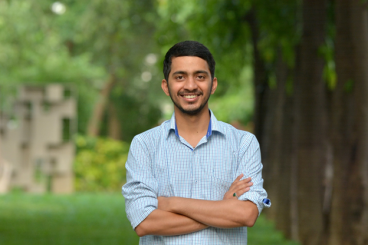Meet CTC: Ramanish Singh

April 14, 2020 -- Ramanish Singh is a second-year chemical engineering graduate student in the Siepmann group. He received his bachelor’s and master’s degree in chemical engineering from the Indian Institute of Technology in Kanpur, India.
Ramanish’s current projects involve first-principles molecular dynamics and Monte Carlo simulations using the CP2K package, which is a Fortran-based software for atomistic simulations with interactions described by Kohn-Sham density functional theory. In the past, he utilized these same tools in an effort to understand the spatial distribution of neighboring molecules in liquid chlorine. Surprisingly, even 250 years after chlorine's discovery, its liquid structure is not yet fully understood.
In the future, Ramanish plans to study phase, sorption, and reaction equilibria using first principles Monte Carlo simulations. His research is part of the Molecular Simulation and Design Framework, an NSF-funded project involving collaborators at nine universities with the goal to develop Python tools enabling TRUE (Transparent, Reproducible, Usable by others and Extensible) molecular simulations.

In his free time, Ramanish enjoys playing ping-pong, biking, doing yoga, and listening to music. He also likes reading short stories, with his favorite being written by Anton Chekhov and R. K. Narayan.
Why did you choose the University of Minnesota, and what led you to join your current research group?
I chose the University of Minnesota for my graduate studies because of the high-quality and interdisciplinary research taking place in both the chemical engineering and chemistry departments. During my bachelor's and master's degree, I had the opportunity to pursue computational research and was inclined towards doing computer simulations for my graduate research. I joined Prof. Siepmann's group because it gives me an opportunity to work on theoretical and applied aspects of computational chemistry and the challenges in chemical engineering.
What is your favorite part about living in the Twin Cities?
The thing I like most about the Twin Cities is that it is a bike-friendly city, with bike lanes everywhere. There are also a lot of scenic bike trails nearby.
How did you become interested in studying chemistry, and what gets you the most excited about your field?
I became interested in chemistry and physics in high school because I learned theories that explained many physical phenomena happening around me. Motivated by my interest in physics and chemistry, I decided to pursue chemical engineering as my major, as it is a mix of both subjects. In my undergrad, I took a course in quantum mechanics and was fascinated by the fact that so much about the world can be predicted just from the Schrödinger equation. This relates to computational chemistry because we can predict the properties and structures of complex chemical systems using computational experiments.

What do you enjoy most about your research? What has been your most interesting or surprising finding so far?
The most interesting thing about my research is that I get to learn new things in statistical mechanics, quantum mechanics, and mathematics every day. My most exciting finding was when I was able to predict the structure of liquid chlorine using density functional theory, and my results matched with the experiments. Computational research acts as a bridge between theoretical and experimental research, so comparing computational research results with the experimental results is a vital part of validating theories.
What drives you to be a better scientist?
My advisor and my group members inspire me, and I have learned (and still am learning) a lot from them. Their dedication towards research and their support motivates me. I also feel that there is so much I do not know, and there is so much left undiscovered. This drives me to work hard in order to discover what is unknown.
What advice, if any, do you have for aspiring scientists?
Always keep yourself updated with the latest research happening in your field of study. This will help you come up with new research ideas.
